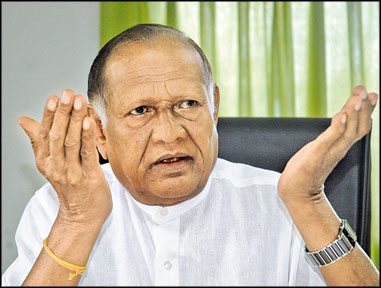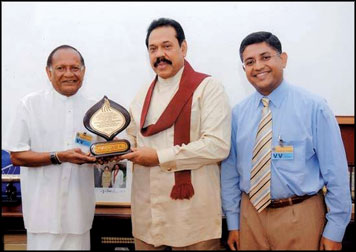|
Dr. Victor Hettigoda:
School drop-out who scaled ladder of success
By Thulasi MUTTULINGAM
|

Pic: Vipula Amarasinghe
|
"I never say the words 'No' or 'can't'!" says Dr. Victor Hettigoda of
the Hettigoda Group, with its famous Siddhalepa brand, on being asked
the secret to his success. "If all young people of this country were to
do the same, the country will have a very bright future."
Deshabandu Dr. Hettigoda has won numerous awards to date for his
contributions in the field of business and Ayurveda, the latest being
the 2010 Presidential Award for Research. He had carried out research
with Dr. Devaka Perera, Professor of Medicine at the Colombo University
on Ayurvedic medication for diabetes which was published in an
international journal in 2005.
Well-known
Today he is a very well-known personality the length and breadth of
Sri Lanka and even internationally but it has been a very, long, long
climb to the top for him; success didn't come easy.
Dr. Hettigoda was born in 1937 in Matara, the fifth of nine children
of the famous astrologer and Ayurvedic physician Dr. Hendrick de Silva
Hettigoda. He descends from generations of eminent ayurvedic physicians.
His father, after learning all he could from his own father, went on to
study medicine from the Rishis (Holy men) of the Himalayas.
He distinguished himself as the best pupil and became the favourite
of his Guru, whom he stayed with for 10 years (returning in between to
Sri Lanka to marry and even have children).
When he finally completed his studies and returned for good to Sri
Lanka, the Rishi, in recognition of his academic merit and also in
gratitude for the fact that Dr. Hendrick de Silva had nursed him through
a long illness had given him the formula for the Siddhalepa balm.
Dr. Hendrick de Silva in turn passed on this secret formula as well
as his other ayurvedic knowledge to only one of his children, Dr. Victor
Hettigoda.
Not an easy path
|

Receiving the Presidential Award |
Asked why he was thus specially singled out, Dr. Hettigoda shrugs. "I
really do not know why. Perhaps Thatha identified from our nine
horoscopes that I would be the businessman making money and so decided
to give it to me, that the product may reach the masses."What had his
father told him about his horoscope? "He told me that there would come a
time when I would have money pouring in from so many different sources
that I wouldn't be able to keep track of it", he smiles.... "I wasn't
sure at the time what he meant but now when I have money coming in from
various countries, businesses and products, I understand."
However, it hasn't been an easy, trailblazing path for him to get
there. He recalls going without lunch for six years in the initial days
he started producing and marketing his Siddhalepa balm. He had dropped
out of school aged 15 to study ayurveda from his father. He spent
another 15 - 20 years travelling about with his father whenever he
visited patients, learning the work first hand.
Business
He was very clear in his own mind that he wanted to have a business
of his own one day; only problem was there was no Business Management
school in those days. "So to know more about things like Finance,
Management, Marketing, Advertising and Distribution, I worked for at
least five different businesses, two government and three private.
"My first salary in 1957 was Rs. 18 per month. I worked as an
accounts clerk at H.I. Hemechandra and they provided me with lodgings
and meals. I learnt a lot working for this company but the most
important thing I learned was the value of money. The salary I drew
would probably be the equivalent of Rs. 2,500 today."
He also worked as a personal assistant to Sirimavo Bandaranaike in
the period 1960 - 1965 where he was responsible for sorting mail sent to
her from the public and sending back her replies. When her government
went into a phase of discouraging all imports and encouraging internal
entrepreneurship, he went into the business of slate making.
"In those days, young children didn't write on exercise books, they
wrote on slates. There were many slates around but I designed one which
had engravings on the back. Alphabets were available in Sinhala, Tamil,
English and also Arabic as engravings on the back of the slate. The
children could practice by tracing their pencils on the engravings. The
business was beginning to take off and I even had twelve people working
under me when the government lifted that particular ban and brought in
exercise books."
Farmer
Next he went into chill planting as farmers were making a killing at
that time. "Just as I was about to make a profit on it, the government
opened up the market on that as well and I made losses." Finally in
1971, he borrowed Rs. 2,500 from a relative and went into the business
of producing his Siddhalepa balm. "I used to go to the market, buy all
the ingredients in various bags and bring them back to work on in a 10 x
10 room. I made and bottled the stuff myself. Then I used to walk and
commute miles with boxes of the product under my arm and on my head to
have them distributed to retailers."
However, it was mostly no go in the initial stages. The market was
already flooded with foreign brands and shop keepers told him they
didn't want 'Sinhala medicine' without even a brand name. That is when
he coined the name Siddhalepa, now an internationally accepted brand.
But he still had a hard time convincing the retailers.
"I told them, why are you promoting foreign brands for money to go
out of the country? This is superior to the products you have, give me a
chance" but it was of no avail. "I travelled round the entire island on
foot, bus and train trying to find some takers. I used to sleep on
pavements which were illegal. I would be rudely woken up by a policeman
and fined.
To escape this, I would beg Buddhist monks to let me sleep in their
Pansalas at night. In order to break even on my income and expenditure,
I skipped lunch - a habit I continued for six years." The cost of
producing a bottle to him was 80 cents. He had failed to market it at Rs.
1 to the shopkeepers. Finally, he pleaded with them to take at least one
bottle at cost price and try it out on themselves and their families.
The strategy worked. The next time he went around, he was welcomed back
and this time the shopkeepers took in mass samples of his product to
sell. He was on his way. |

